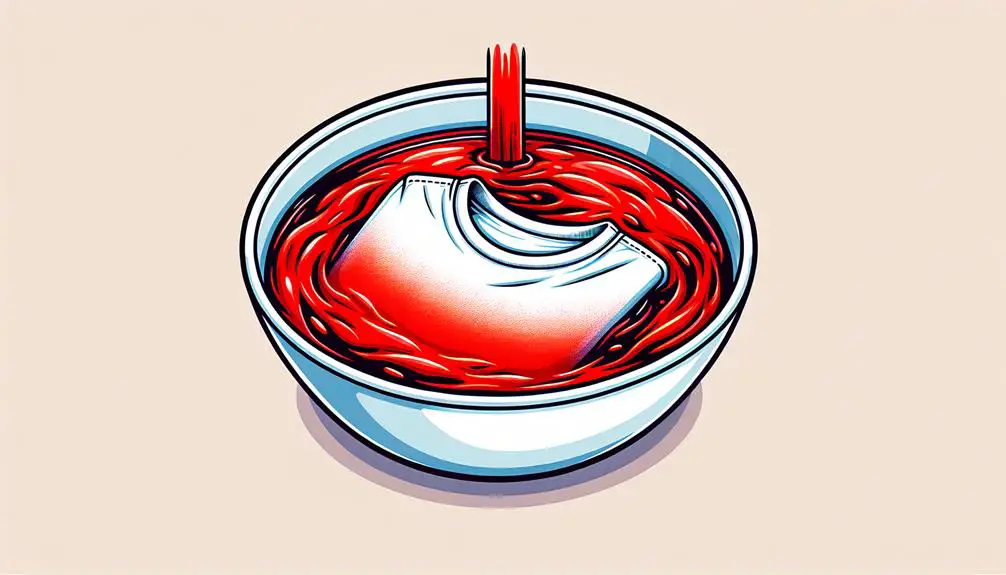I've always heard that vinegar is a miracle worker when it comes to setting colors in clothes, but does it really live up to the hype?
The idea of using a pantry staple to lock in those vibrant hues sounds too good to be true, but there might be more to it than meets the eye.
Let's explore the science behind vinegar's color-setting powers and uncover whether it's truly a game-changer in the laundry room.
Table of Contents
Key Takeaways
- Vinegar enhances color setting, prolongs fabric lifespan, and prevents premature fading.
- Incorporating vinegar in the dyeing process acts as a natural fixative and locks in dyes.
- Vinegar helps achieve long-lasting color-fast results by maintaining vibrancy and preserving fabric integrity.
- Vinegar's color-lock secret prevents color bleeding, ensures vivid colors, and enhances color-fast outcomes.
Benefits of Using Vinegar
Using vinegar in laundry offers a multitude of benefits that can enhance the effectiveness of your washing routine and prolong the lifespan of your clothes. When it comes to color preservation, vinegar plays a crucial role in setting colors, especially in natural fabrics, and preventing fabric fading. Its acidic nature helps lock in the colors of your clothes, making them last longer without the risk of bleeding onto other garments. This is particularly useful for vibrant or dark-colored items that are prone to losing their intensity over time.
Incorporating Vinegar in Dyeing Process
When exploring the benefits of vinegar in laundry, one essential application is incorporating it into the dyeing process to effectively set colors in fabrics. Vinegar, acting as a natural fixative, can help lock in dyes and prevent color bleeding during the dyeing process.
Adding vinegar to the final rinse cycle when dyeing fabrics can significantly enhance color fastness, ensuring the colors remain vibrant over time. This simple method of using vinegar in dyeing isn't only cost-effective but also environmentally friendly, making it a preferred choice for those looking to set colors in fabrics without harsh chemicals.
Achieving Color-Fast Results
I've found that using vinegar in the laundry not only sets colors but also helps fabrics maintain their vibrancy over time.
The secret lies in vinegar's ability to lock in dyes, providing long-lasting protection against fading.
Vinegar's Color-Lock Secret
To achieve color-fast results and lock in vibrant hues, harness the color-lock secret of vinegar's natural fabric softening properties. When washing clothes, adding vinegar to the final rinse helps set the dye and prevent colors from bleeding. The acetic acid in vinegar acts as a gentle fixative, ensuring that the colors remain vivid and true.
This process not only preserves the integrity of the fabric but also aids in maintaining the brightness of new or bright clothing items. By incorporating vinegar into your laundry routine, you can enhance color-fast results, prevent color transfer, and extend the lifespan of your favorite garments.
Embracing vinegar's color-lock secret is a simple yet effective way to protect your clothes and keep them looking vibrant wash after wash.
Long-Lasting Dye Protection
For long-lasting dye protection and vibrant colors, incorporating vinegar into your laundry routine is a simple yet effective solution. By adding vinegar to the final rinse cycle, you can achieve color-fast results and maintain the fabric vibrancy of your garments.
Here are four key benefits of using a vinegar rinse for dye protection:
- Color Set: Vinegar helps seal in dyes, preventing color bleeding and ensuring colors stay true.
- Fabric Vibrancy: The natural fixative properties of vinegar aid in preserving fabric colors, keeping them bright.
- Dye Protection: Vinegar acts as a protective shield for dyes, extending the lifespan of colors.
- Eco-Friendly: Using vinegar is a sustainable and cost-effective method to protect colored garments while being gentle on the environment.
Understanding Color Setting Mechanism
Understanding the color setting mechanism involves delving into how vinegar's acetic acid interacts with fabric dyes to lock in and enhance color vibrancy. When vinegar is used in the laundry process, the acetic acid present in it plays a crucial role in binding the dye molecules to the fabric fibers. This process not only helps in preventing color bleeding during washing but also contributes to better color retention over time. The acidic nature of vinegar creates an environment that effectively sets colors without the need for harsh chemicals, thus preserving the vibrancy of colored clothes in a natural and eco-friendly way.
| Advantages of Using Vinegar for Color Setting | Description |
|---|---|
| Natural Fixative | Binds dye molecules to fabric fibers |
| Enhanced Color Retention | Locks in colors and prevents fading |
| Eco-Friendly and Cost-Effective | Simple yet efficient method for setting colors |
Vinegar Types for Color Setting
When selecting vinegar for color setting, consider the type that aligns best with your fabric preferences and desired scent neutrality. Different types of vinegar, such as distilled white vinegar and apple cider vinegar, can be chosen based on specific fabric needs for color setting.
Here are some key points to keep in mind:
- Distilled White Vinegar: Commonly used for setting colors due to its neutral color and mild scent, making it ideal for those who prefer a fragrance-free option.
- Apple Cider Vinegar: Can also be used for color setting, but it may impart a slight apple fragrance to fabrics, which could be appealing for some individuals.
- Specific Fabric Needs: Choose the type of vinegar based on the fabric you're treating to ensure compatibility and effective color setting.
- Washing Machine Application: Add vinegar to the final rinse cycle of the washing machine to help set colors effectively and prevent bleeding, ensuring your garments maintain their vibrant hues.
Selecting the right vinegar type can make a significant difference in preserving your fabrics' colors while catering to your specific preferences and needs.
Proper Washing Techniques With Vinegar
Considering the benefits of vinegar as a natural color fixative, incorporating proper washing techniques with vinegar can effectively enhance color retention in fabrics. When using vinegar in your laundry routine, it's crucial to follow specific steps to ensure the best results. One important tip is to add half a cup of vinegar to the final rinse cycle when washing colored clothes. This helps set the dye and retain the vibrancy of the colors. Additionally, using warm water temperatures can aid in the process of color setting while preventing color bleeding.
| Washing Technique | Description | Importance |
|---|---|---|
| Half a cup of vinegar | Adding this to the final rinse cycle helps set dye and prevent color bleeding. | Enhances color retention |
| Warm water temperature | Using warm water can assist in setting the color in fabrics while washing. | Prevents color bleeding |
| Limited washing cycles | Avoiding excessive washing can help retain color vibrancy and increase the garment's longevity. | Preserves color integrity |
Tips for Long-Lasting Color Results
For achieving vibrant and long-lasting color results in your laundry, incorporating vinegar as a color fixative is a simple yet effective technique. Here are four tips to help you set the colors, prevent color bleeding, and minimize color fading in your clothes:
- Utilize vinegar in the rinse cycle: Adding vinegar during the rinse cycle can aid in setting colors and reducing the likelihood of bleeding between different colored fabrics.
- Preserve color vibrancy: Vinegar acts as a natural fabric softener, lessening friction during the washing process and helping to maintain the vibrancy of colors in your garments.
- Extend the life of colored clothing: By properly setting colors with vinegar, you can significantly prolong the lifespan of your colored clothing items and prevent them from fading prematurely.
- Achieve long-lasting color results: Following specific vinegar application methods will assist you in achieving durable and long-lasting color results in your laundry, ensuring that your clothes look vibrant and fresh for longer periods.
Frequently Asked Questions
How Do You Set Dye With Vinegar?
To set dye with vinegar, I mix it in the final rinse cycle. The vinegar seals the color, preventing bleeding. It's an effective method that helps maintain color vibrancy and prevents fading, ensuring my clothes stay bright.
Can Vinegar Be Used as a Dye Fixative?
Yes, vinegar can be used as a dye fixative for some natural dyes. It helps set colors in fabrics like cotton or wool. Always test on a small area first. Follow instructions carefully for best results and avoid damaging the fabric.
What Can I Use as a Color Fixative?
I use Retayne for maintaining vibrant colors in fabrics. Following care instructions is key for color setting. Color Catcher sheets also help prevent dye bleeding. Vinegar historically set dyes, but modern cotton dyes don't need it.
Will Vinegar Change Clothes Color?
Using vinegar to set colors won't change my clothes' color. It seals in colors, prevents bleeding, and maintains vibrancy. Diluted vinegar in the rinse cycle is safe and effective, acting as a fixative without altering original colors.
- Tetron Fabric for Furniture: Style and Durability Guide - June 18, 2025
- Tetron Fabric for Industrial Safety: Applications and Benefits - June 18, 2025
- Tetron Fabric for Medical Textiles: Hygiene and Safety Standards - June 18, 2025







